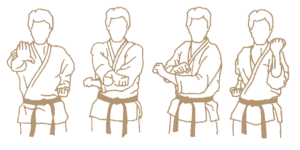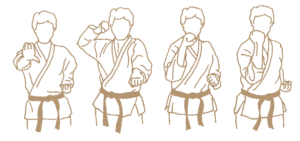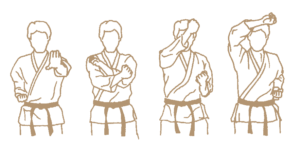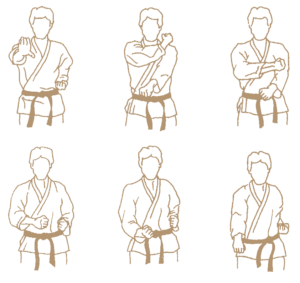Blocks (Uke) are used to defend against arm and leg attacks toward any part of the body. They have also been used effectively against weapons attacks, however, this is not recommended. Most Karate blocks are arm techniques done with a closed fist or open hand, but the legs (knees and feet) can also be trained to block.
If applied correctly, Karate blocks will stop or deflect any direct attack no matter how quick or powerful it is. An effective block will avoid a direct hit and give the person being attacked a precious split second to make a decisive counter attack or subdue the aggressor.
Only use your Karate attack skills when necessary. There is a familiar say known to Karate practitioners around the world “karate ni sente nashi.” When translated it means “There is no first attack in karate.” This maxim has become known primarily through the teachings of Gichin Funakoshi.
Did you notice that the first move of every Kata is a block?...
In martial arts, knowing how to block an opponent’s strikes is equally as important as learning to punch, kick, counter strike, and evade. There are many different blocking techniques used, however there are four main types of Karate arm blocks that are utilised for defending against standard punches and kicks:
1.The Inward Block
Movement: From guard position, turn your left arm to the right (inward), leaving your closed fist turned towards your face.
Application: Inward blocks, also referred to as inside blocks, are a great way to deflect straight punches and kicks to the head, such as jabs and side kicks. Ideally, the inside forearm will meet the striker’s forearm, or back of the leg, pushing it out and away from the head.

An example of an inward block is the Uchi--ude-uke.
2.The Outward Block
Movement: From guard position, turn your left arm to the left (outward), leaving your closed fist facing away from your face.
Application: An outward block, also called an outside block, is an effective way to block reverse punches and reduce the impact from roundhouse kicks. When blocking a wide swinging punch, aim to strike the inside of the striker’s forearm with the strong outer forearm bone.

An example of an ioutward block is the Soto--ude-uke.
3.The Upper Block
Movement: From guard position, turn your left arm to the left (outward) and raise your arm above your head, leaving your closed fist facing away from your face.
Application: Upper blocks, sometimes called high blocks, are a good way to block hammer punches and prevent damage caused by axe kicks. When blocking a hammer punch, use the outer forearm against the opponent’s forearm in effort to deflect the strike.

An example of an upper block is the Age-uke.
4.The Lower Block
Movement: From guard position, turn your left arm to the right (inward) and lower your arm down towards the side of the leg, leaving your closed fist facing towards your body.
Application: Low blocks can be used to prevent strikes to the mid-body, such as side kicks, roundhouse kicks, and hook punches. Try to reduce damage to the ribs by blocking strikes with the outer forearm.

An example of a lower block is the Gedan-barai.
It’s important to regularly practice these standard karate blocks so that your body can react instinctively when sparring and faced with physical confrontation. Speak with your instructor about improving your form and becoming more effective with your blocking moves.
Timing of Blocks
Of all the basic Karate moves, timing (more than speed) is critical to the success of Karate blocks. A block will fail if it does not meet an attack at the right moment. Speed is essential too but it must be used relative to the speed of the attack.
Turning Blocks into Attacks
Karate blocks are usually followed by a decisive counter attack. This switches the advantage back to the defender. Skilled Karateka can combine perfect timing with the right amount of power to turn Karate blocks into attacks. This is one of the benefits of long-term training in the Karate basics.
Blocks in a Real Situation
Outside of the dojo, a Karateka does not have the luxury of an opponent pausing to announce his attack. When someone trains correctly in the basic Karate moves there comes a point when there is no conscious decision to block. This is when Karate blocks become instinctive – and just as well because they might just save your life!
Although not listed in the blocking section, many of the strikes used in Karate can also be used as blocks and vice versa, many blocks can be used as strikes. Uke can be divided into 4 Karate Block Categories:
- Basic Closed-Hand Blocks
- Open-Hand Blocks
- Advanced Blocks
- Double-Hand Blocks
Uke (Block)
| Japanese | Pronunciation | Kanji | English |
|---|---|---|---|
| Uke | oo-kay | 受 | Block |
| Age-uke | ah-gay oo-kay | 上げ受 | Rising Block |
| Chudan-soto-uke | chew-dahn so-toe oo-kay | 中段外受 | Middle Outward Bock |
| Chudan-uchi-uke | chew-dahn oo-chee oo-kay | 中段内受 | Middle Inward Block |
| Gedan-barai | geh-dahn bah-rye | 下段払い | Lower Sweeping Block |
| Gedan-uke | geh-dahn oo-kay | 下段受 | Lower Level Block |
| Haito-uke | hai-toh oo-kay | 背刀受 | Reverse Knife-hand Block |
| Hangetsu-barai-uke | hahn-geh-tsue bah-rye oo-kay | 半月払受 | Half-moon Sweeping Block |
| Hari-uke | hah-rae oo-kay | 払受 | Sweeping Block |
| Hasami-uke | hah-sah-me oo-kay | 鋏受 | Scissor Block |
| Hazushi-uke | hah-zoo-she oo-kay | 外受 | Removing Block |
| Hiji-uke | he-jee oo-kay | 肘受 | Elbow Block |
| Jodan-uke | joh-dahn oo-kay | 上段受 | Upper Level Block |
| Kosa-uke | koe-sah oo-kay | 交差受 | Cross Block |
| Magetori-barai-uke | mah-geh-toh-ree bah-rye oo-kay | 髷取 払受 | Rising Double Knife-hand Block (lit. Grabbing the Topknot Block) |
| Makite-uke | mah-key-teh oo-kay | 巻手受 | Winding Knife-hand Block |
| Morote-barai-uke | moh-row-teh bah-rye oo-kay | 諸手払受 | Augmented Lower Block |
| Morote-soe-uke | moh-row-teh so-eh oo-kay | 諸手添受 | Augmented Forearm Block, Wedge Block |
| Otoshi-uke | oh-toe-she oo-kay | 落受 | Dropping Block |
| Sagurite-uke | sah-gu-ree-teh oo-kay | 探手受 | Searching-hand Block |
| Sasae-uke | sah-sa-eh oo-kay | 支受 | Supported Forearm Block |
| Sayu-barai-uke | sah-yoo bah-rye oo-kay | 左右払受 | Double Sweeping Block (lit. Left-right Sweeping Block) |
| Shotei-uke | show-tay oo-kay | 掌底受 | Palm Heel Block |
| Shuto-uke | shoe-toe oo-kay | 手刀受 | Knife Hand Block |
| Torite-uke | toh-ree-teh oo-kay | 捕手受 | Grasping-hand Block |
| Wari-uke | wah-rhee oo-kay | 割受 | Split Block |



